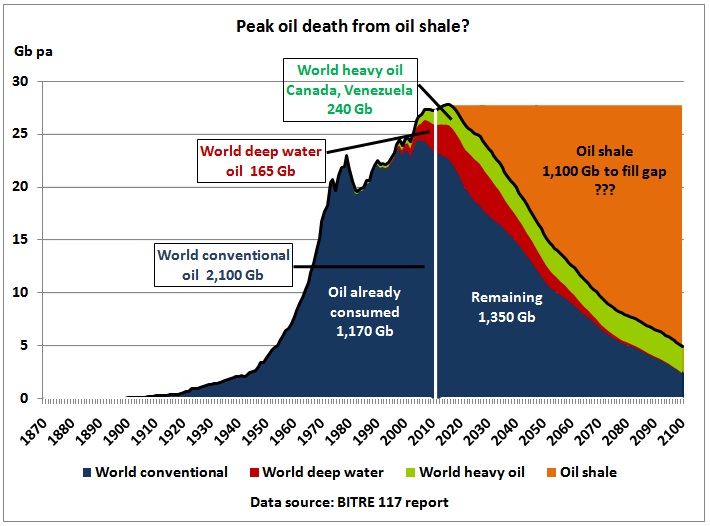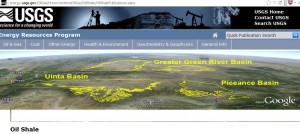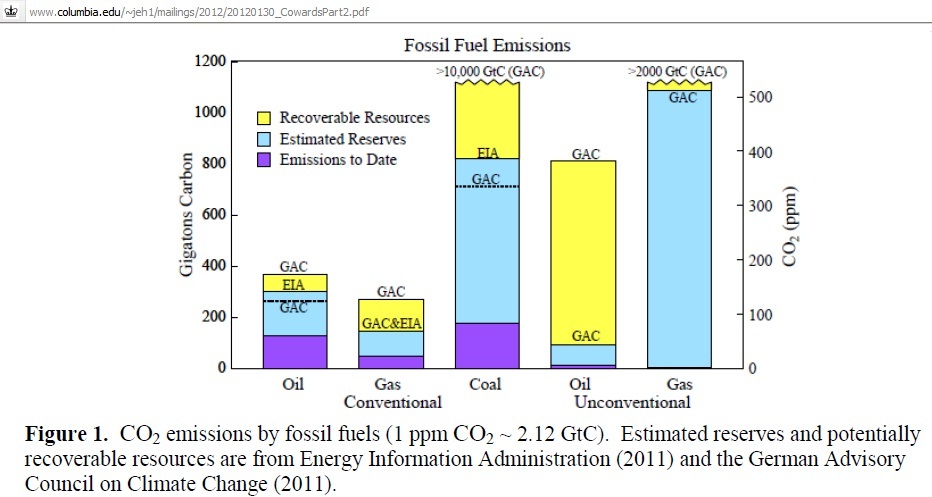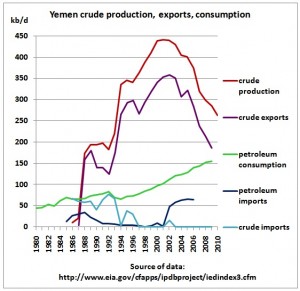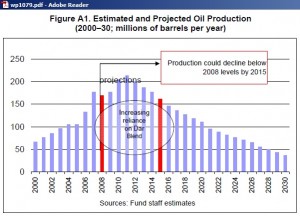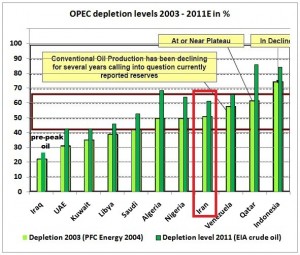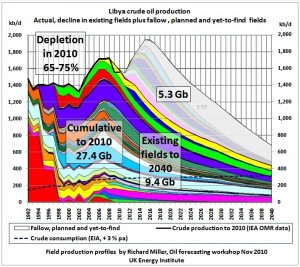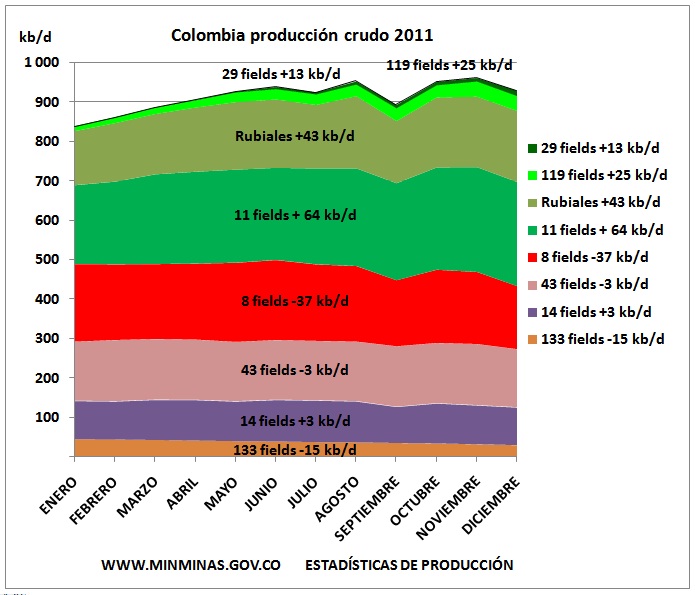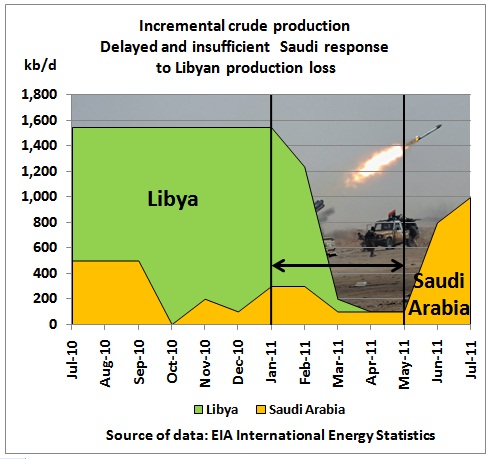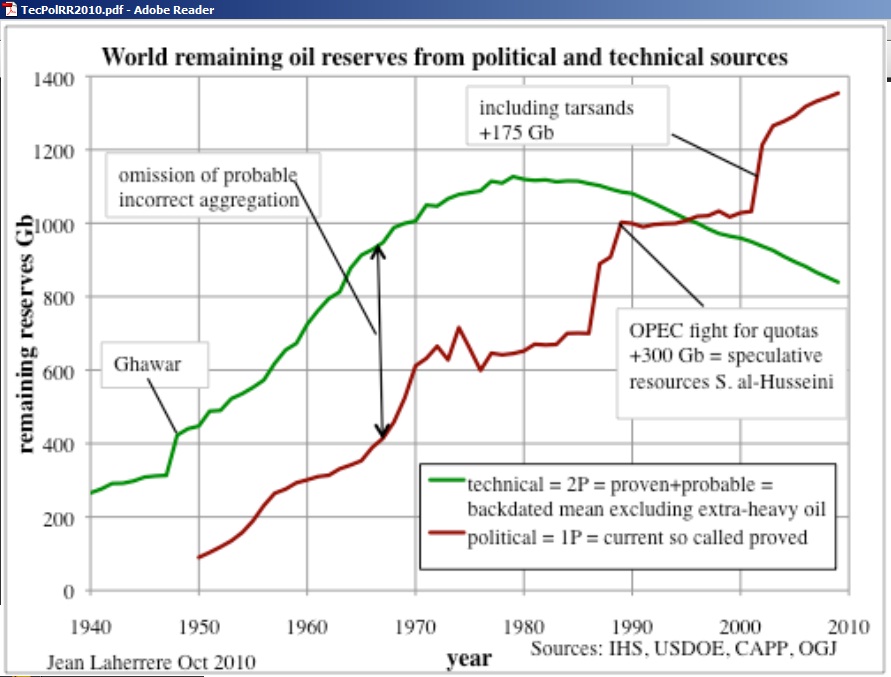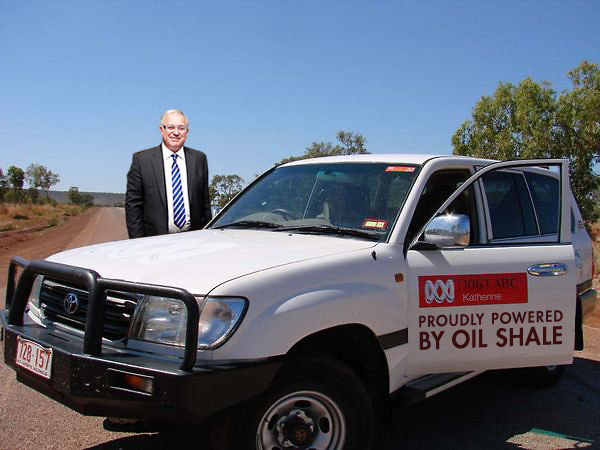 Science or fiction? Here, ABC TV star journalist A. Kohler is seen testing synthetic fuel produced from Australia’s vast deposits of kerogen (graphics: Ian McPherson)
Science or fiction? Here, ABC TV star journalist A. Kohler is seen testing synthetic fuel produced from Australia’s vast deposits of kerogen (graphics: Ian McPherson)
It is more than a month ago that Alan Kohler mixed up oil shale (kerogen) and shale oil (tight oil). He claimed that there are 2 trillion barrels of shale oil (while current estimates in the US are only 24 Gb) and that we shouldn’t worry about peak oil anymore. As of writing this post, his original article still stands uncorrected although I had written several emails that ABC TV adds an amendment. Kohler’s article will contribute to mis-investments in oil dependent infrastructure.
What’s worse, the Business Spectator, in trying to support Alan Kohler’s piece on a premature peak oil death, gave space on its website for Keith Orchison from Coolibah Consulting to write his opinion, “Scaling the peaks of Kohler’s oil clash“, 20 March 2012, again without numbers. This is especially strange as Keith was once executive director of APPEA and is now member of the Energy White Paper Reference Group. Keith ridicules statistics (to be thrown on the “pyre”), talks about “peak oil noise” and has scornful comments about the IEA where he has discovered “less bold plateau oilers”. Such polemic, verbal terms are un-professional and do not contribute any useful information to peak oil research.
This article is an analysis of Keith’s piece.
Contents:
(1) History of recent debating club proceedings
(2) Filling the gap
(3) Where are those 2 trillion barrels of oil?
(4) Peak oil and global warming not a religious question
Some reader responses Keith was reluctant to look at:
(5) Oil shale resources in Queensland
(6) Stuart Oil Shale plant dismantled
(7) Some well count numbers
(8) Different risk assessments for peak oil and global warming
Keith’s peak oil noise that will not go away
(9) Crude oil peak started in 2005
(10) US shale oil in context of 1970 peak
(11) Sudan, Yemen and Syria: 3 countries after the peak
(12) Additional oil reaching the market
(13) Citi bank’s US energy independence myth
(14) APPEA’s Adelaide conference and the Saudis
(1) Debating history so far:
29/2/2012 Kohler article on ABC TV website “Oil reserves shift global markets”
7/3/2012 Post on my crudeoilpeak website “No number crunching in Alan Kohler’s opinion piece on a premature peak oil death”
19/3/2012 A short version of my article appears on the Climate Spectator web site “Why Kohler is wrong on peak oil”
20/3/2012 Keith Orchison’s attempt to prove Kohler is right
Scaling the peaks of Kohler’s oil clash
(2) Filling the gap
In this graph – using the estimate from the BITRE 117 report – the world would need 1,100 Gb of oil shale until 2100 to fill the gap between declining oil production and the current level of consumption. Let’s see what Keith has on offer.
(3) Where are those 2 trillion barrels of oil?
We read:
K. Orchison: The commentary drew 168 responses on The Drum in addition to those in response to its first appearance in Business Spectator. To which you can add 87 responses to a critical piece in Crikey and a shoulder charge from a contributor to Climate Spectator, who told him that “none of your statements can be supported by statistical evidence.”
Well, the shoulder contributor was me, with a short version of this much more detailed post:
7/3/2012
No number crunching in Alan Kohler’s opinion piece on a premature peak oil death
This new post is response n+1. Now if you thought that Keith presented some figures this time round – including links to related and authoritative websites – you expected too much. In the contrary, the verbal arguing continues:
K.Orchison: Kohler, in his article drawing fire from the doom-and-gloomsters, argues that the US alone has an estimated two trillion barrels of shale oil reserves (eight times what Saudi Arabia claims) and points to large prospects in Australia and elsewhere.
His critics say he is confusing reserves and resources, the former being the highly desirable 3P target for explorers (proven, possible and probable), and that in any case the big problem is that accessing shale oil will create a whole new threat to life on the planet as we know it, by adding to global carbon dioxide emissions.
Comment: So where are the details on these 2 trillion barrels? The huge “shale oil reserve” Kohler is referring to is actually oil shale which has very little to do with the tight oil producible by new fracking techniques which are supposed to bring a new era of oil. The problem with oil shale was already known to peak oilers in 1998:
HUBBERT CENTER NEWSLETTER # 98/4
SHALE OIL–THE ELUSIVE ENERGY
Nature of oil shale. Shale oil comes from oil shale, but oil shale is a misnomer. It is neither a true shale nor does it generally have any oil in it. It is better identified as organic marlstone, marl being a mixture of clay and calcium carbonate. The organic material is kerogen, derived from myriad organisms, chiefly plants. Savage (1967) notes the term “oil shale” is a promotional term: “The magic word ‘oil’ would raise large sums of promotion money while organic marlstone wouldn’t raise a dime.”
Estimates of the volume of potential oil in the U. S. shale deposits have grown steadily since
they were first studied in detail by the USGS in the early 1900’s. Duncan (1981) states “The oil shale deposits of the United States can be considered collectively as an enormous low-grade source of oil, hydrocarbon gas, or solid fuel. Deposits with an estimated yield of 10 gallons or more oil per ton of rock contain more than 2 trillion barrels; their possible extensions may contain an additional 3 trillion barrels; and, speculatively, other unappraised deposits may contain several times as much oil.”
http://hubbert.mines.edu/news/Youngquist_98-4.pdf
This is the underlying oil geological origin of oil shale:
 June 2006 http://pubs.usgs.gov/sir/2005/5294/pdf/sir5294_508.pdf
June 2006 http://pubs.usgs.gov/sir/2005/5294/pdf/sir5294_508.pdf
Not much has changed in 10 years:
Expectations for Oil Shale Production (Issues in Focus AEO2009)
Oil shales are fine-grained sedimentary rocks that contain relatively large amounts of kerogen, which can be converted into liquid and gaseous hydrocarbons (petroleum liquids, natural gas liquids, and methane) by heating the rock, usually in the absence of oxygen, to 650 to 700 degrees Fahrenheit (in situ retorting) or 900 to 950 degrees Fahrenheit (surface retorting) . (“Oil shale” is, strictly speaking, a misnomer in that the rock is not necessarily a shale and contains no crude oil.)
The in situ processes now under development raise the temperature of shale formations by using electrical resistance or radio wave heating in wells that are separate from the production wells. Also being considered are “ice walls”—commonly used in construction—both to keep water out of the areas being heated and to keep the petroleum liquids that are produced from contaminating aquifers….. [you get the idea]
Although the technical feasibility of in situ retorting has been proved, considerable technological development and testing are needed before any commitment can be made to a large-scale commercial project. EIA estimates that the earliest date for initiating construction of a commercial project is 2017. Thus, with the leasing, planning, permitting, and construction of an in situ oil shale facility likely to require some 5 years, 2023 probably is the earliest initial date for first commercial production.
http://www.eia.gov/oiaf/aeo/otheranalysis/aeo_2009analysispapers/eosp.html
 << May 2010, estimate in the EIA Annual Energy Outlook.
<< May 2010, estimate in the EIA Annual Energy Outlook.
Oil shale production starting after 2020 and then only in tiny quantities of around 250 kb/d
“With ongoing improvement in oil shale technology,
commercial production starts in 2023 and increases
rapidly to 1.7 percent of total U.S. liquids supply in
2035. However, oil shale development suffers from
environmental, technical, and financial uncertainties
similar to those for CTL.”
http://www.eia.gov/oiaf/archive/aeo10/index.html
HAPPY MOTORING! This will not rescue us from peak oil.
And this is the 2011 assessment:
“The Eocene Green River Formation of Colorado, Utah, and Wyoming contains the largest oil shale deposits in the world. Oil shale, despite the name, does not actually contain oil, but rather a type of organic matter called kerogen, a precursor of oil that is converted to a type of crude oil when heated to about 450 – 500° C. Estimated total in-place resources [not reserves] are about 1.5 trillion barrels of oil for the Piceance Basin, about 1.3 trillion barrels of oil for the Uinta Basin and 1.44 trillion barrels of oil in the Green River Formation”
http://energy.usgs.gov/OilGas/UnconventionalOilGas/OilShale.aspx
(4) Peak oil and global warming not a religious question
K.Orchison: Like the climate change debate itself, the peak oil argument can never be resolved between believers and non-believers. As the multitude of responses to Kohler’s commentary demonstrate, everyone has a statistic to throw on the pyre.
Comment: Neither peak oil nor global warming is a religious problem. The laws of physics (fluid mechanics, thermodynamics) control these processes and they have to be learned, not debated. It is incomprehensible that such an unscientific approach is used in the context of our modern world where we use computers to calculate about everything we can think of. The intention is apparently to discredit any attempt to use statistics (because they show peak oil), even ridicule them.
(5) Oil shale resources in Queensland
As a result of this mindset Keith couldn’t be bothered to check some of the “multitude of responses”, for example:
Michael writes: “Queensland has known oil shale reserves at least equal to Saudi Arabia’s total oil reserves, but to date extraction has been uneconomic.”
Comment: Let’s check it, it’s 22.4 Gb, much less than Saudi Arabia’s claimed “reserves” of 260 Gb. From Geoscience Australia:
“Australia’s total identified energy resource contained in oil shale was estimated at 131 600 PJ (22 390 mmbbl) in 2009 (table 3.8). However, all of this was classified as either recoverable contingent (84 600 PJ, 14 387 mmbbl) or inferred (47 000 PJ, 8003 mmbbl) resources. This is a large unconventional oil resource.”
Extract from page 57:
“Small scale production of hydrocabons (kerosene, lamp oil, fuel oil, and other products) from oil shale began in several countries in the late 1800s including Australia with production from the torbanite deposits at Joadja Creek near Lithgow and at Glen Davis (both in New South Wales) from 1865. This production continued through World War II until 1952. There was also production in the period 1910–34 from the Mersey River tasmanite deposits in Tasmania.”
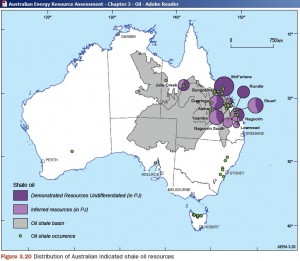 https://www.ga.gov.au/products/servlet/controller?event=GEOCAT_DETAILS&catno=70142
https://www.ga.gov.au/products/servlet/controller?event=GEOCAT_DETAILS&catno=70142
(6) Stuart Oil Shale plant dismantled
Extract from the Australian Mines Atlas:
Shale Oil
Oil shale is organic-rich shale, which yields substantial quantities of oil (normally referred to as shale oil) and combustible gas by heating (retorting) and distillation. The organic material in oil shale is called kerogen, which under appropriate conditions in the Earth’s crust can be a precursor to conventional oil reservoirs. One tonne of commercial grade oil shale may yield from about 100 to 200 litres (L) of oil.
Production
In September 2011, Queensland Energy Resources Ltd (QER) produced its first crude oil from its demonstration Paraho IITM vertical shaft kiln processing plant at the Stuart deposit near Gladstone, central Qld. The oil is being stored in secure tanks on-site, awaiting commissioning of the oil upgrading unit (refinery).
There was no oil being extracted from oil shale in Australia between 2004 and September 2011. From 2000 to 2004, the previous demonstration processing plant at the Stuart deposit (Qld) produced more than 1.5 million barrels of oil using a horizontal rotating kiln process (Alberta Taciuk Process). The facility has been dismantled and the site remediated.
The demonstration plant achieved stable production capacity of 6000 tonne of shale per day and oil yield totalling 4500 barrels per stream day while maintaining product quality and adhering to Environment Protection Authority emissions limits. The oil products from the demonstration plant were Ultra Low Sulphur Naphtha (ULSN) 55% to 60% and Light Fuel Oil (LFO) 40% to 45%. The ULSN, which can be used to make petrol, diesel and jet fuel, has a sulphur content of less than one part per million (ppm). To put this into perspective, from January 1, 2008, the Fuel Standard (Petrol) Determination regulated that the maximum content of sulphur is 50ppm in premium unleaded petrol.
http://www.australianminesatlas.gov.au/aimr/commodity/shale_oil.html#shale_oil
Stuart Oil Shale Project
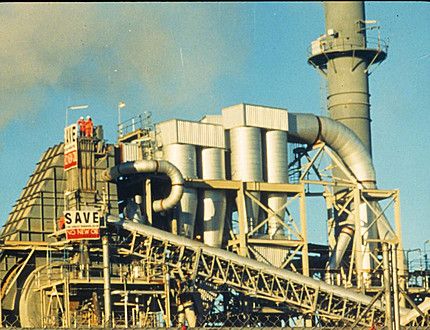 Stuart oil shale pilot plant (2004), now dismantled
Stuart oil shale pilot plant (2004), now dismantled
http://en.wikipedia.org/wiki/Stuart_Oil_Shale_Project
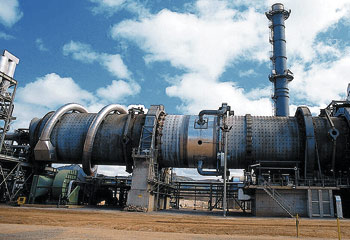 http://resources2.news.com.au/images/2008/08/25/va1237326525885/Stuart-Shale-Oil-Plant-6216734.jpg
http://resources2.news.com.au/images/2008/08/25/va1237326525885/Stuart-Shale-Oil-Plant-6216734.jpg
So this shale-to-liquids process has nothing to do with Alan Kohler’s fracking boom of tight oil.
(7) Some well count numbers
From Peter Strachan (http://www.stockanalysis.com.au/ )
Peak oil is not about how much you have in the ground, ts about how much you can extract on a daily basis. I doubt that we will ever see more than 92 million barrels of oil pa over a whole year. Currently, the oil industry has to deliver about 4.2 mmbbls per day of new oil supply each year, just to hold steady at around 89 mmbbls.
A big new find today is 100 mmbbls, whereas that would have been small fish in the 1960’s. The USA currently uses 7 billion barrels of liquid hydrocarbons (crude & condensate, LPG, tar sands and biofuels) per year and imports 4 billion of those barrels. It is not ever going to be self sufficient again.
These shale wells deliver 75% of their oil in the fist 18 months of operation and then settle at a low production rate. In order to supply 4 billion barrels of oil pa at 20 bbls per day per well requires 548,000 wells, so they would have to drill 150 wells per day over 10 years to achieve this. Not going to happen.
(8) Warming in the pipeline from current CO2
One reader mentions this paper from NASA climatologist James Hansen:
“Earth has warmed in the past century by about 0.8°C, with most of the warming caused by human-made greenhouse gases, mainly CO2 from fossil fuel burning. Earth was out of energy balance during the recent solar minimum, more energy coming in than going out, which reveals that the largest natural climate forcing (solar variability) is overwhelmed by increasing greenhouse gases. The imbalance also proves that there is substantial additional global warming “in the pipeline” even without additional increase of atmospheric CO2. Extreme climate anomalies such as the Texas-Oklahoma heat wave of 2011 and the Moscow heat wave of 2010 have increased in frequency to such a degree that they can be ascribed to global warming with a high degree of confidence. Paleoclimate data show that additional global warming of even another degree Celsius would cause irreparable harm to young people and other species.”
“Advertisements that tar sands and shale oil are beneficial, providing energy independence and jobs, repeated hundreds of times a day, are an attempt to brainwash the public into supporting policies that enrich the few, while screwing the public, especially young people.”
http://www.columbia.edu/~jeh1/mailings/2012/20120130_CowardsPart2.pdf
Dean Sorley writes: Matt, you correctly point out the difference between reserves and resources, then go straight on to make the same mistake you accuse Alan of making – you ring the alarm bell about the burning of 50% or resources, not reserves.
Comment: This is an interesting point. Well it could be that 50% is a too high recovery factor to turn resources into reserves but what is more important is that this critique highlights the difference in risk assessment between peak oilers and climatologists:
Peak oilers analyse the question: “what will happen to the economy if there is less oil than generally assumed, leading to a decline in oil production?”
Climatologists calculate what will happen to the climate if fossil fuels are burnt to their maximum. They will not, to be on the safe side, rely on the low side of resource/reserve assessments of peak oilers.
In other words: the worst case scenarios are different. Both approaches are valid and must be considered. However, there is system dynamics involved. If the combination of financial crisis and high oil prices impact negatively on budgets (as they do now) the massive projects to reduce CO2 may not be financed in time. I had outlined this in my post
System Dynamics peak oil, financial and CO2 debt, ME geopolitics
http://crudeoilpeak.info/system-dynamics-peak-oil-financial-and-co2-debt-me-geopolitics
(9) Crude oil peak started in 2005
K. Orchison: But it is not possible to realistically assert that the perspectives of 2010, when the peak oil noise was last at its peak (sorry), are equally valid in 2012.
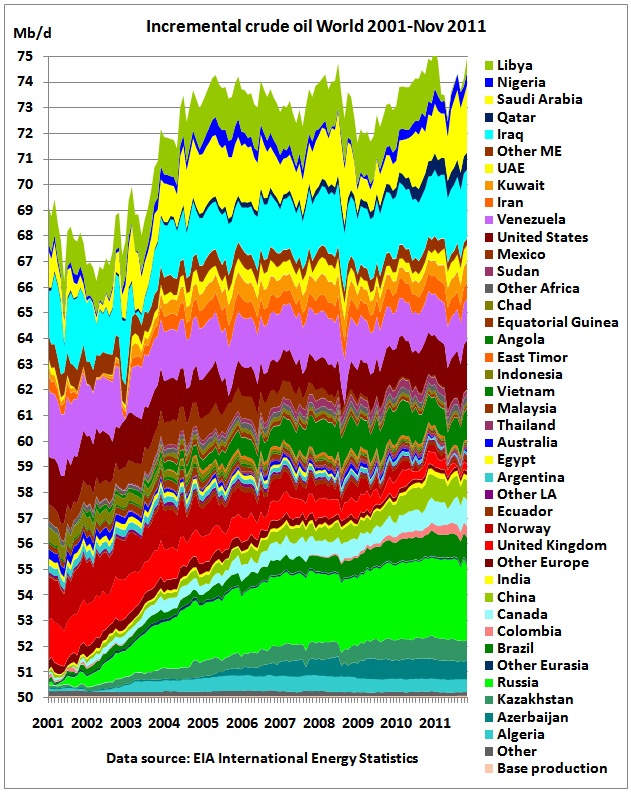 Comment: Of course it is possible:
Comment: Of course it is possible:
<< We are still on a bumpy crude oil production plateau.
World oil markets slowly realize that the assumed OPEC spare capacity is much lower than previously assumed.
From the IEA:
14 March 2012
“Tight market fundamentals and risks surrounding Iran underpin 20% rise in crude prices since December” says Oil Market Report
(10) US shale oil in context of 1970 peak
K.Orchison: Standing back, one can see American production slowly rising again as a result of the shale revolution, as conventional resources such as those in Alaska begin their decline and the Gulf of Mexico looks like finally making a comeback from the Macondo disaster.
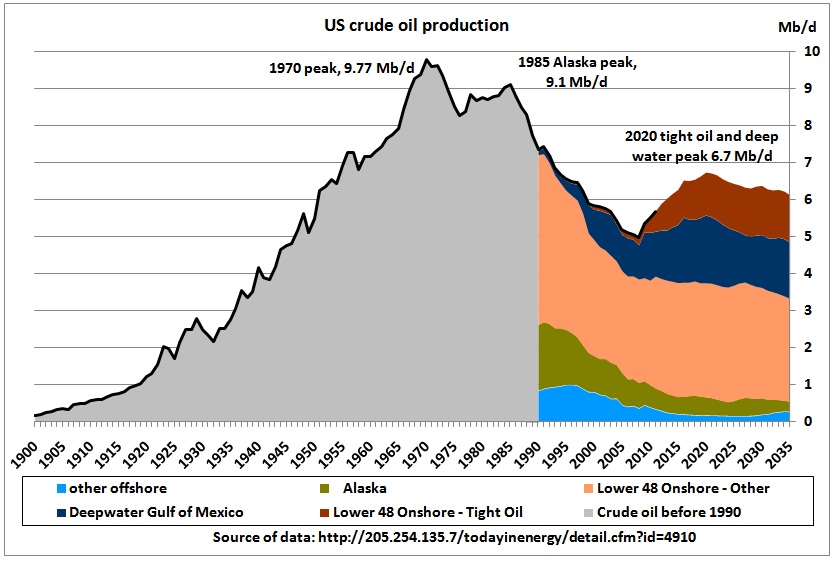 OK, let us stand back and look at the US oil production history, including an estimate from the EIA. Yes, there is an uptick but this is not a revolution which cancels out the US oil peak in 1970.
OK, let us stand back and look at the US oil production history, including an estimate from the EIA. Yes, there is an uptick but this is not a revolution which cancels out the US oil peak in 1970.
(11) Sudan, Yemen and Syria: 3 countries after the peak
K.Orchison: Meanwhile about half a million barrels of production a day has been yanked out of the market because of big-time hassles in South Sudan, Yemen and Syria
Comment: ….3 countries in which peak oil has already happened.
31/5/2011
Sudan’s Nile blend in decline – why we should be concerned
http://crudeoilpeak.info/sudan-nile-blend-in-decline-why-we-should-be-concerned
(12) Additional oil reaching the market
K. Orchison: On the other hand, additions to supply could soon be reaching the market from Iraq, Angola, Libya and Colombia.
Iraq: Yes, Iraq is about the only country in the Middle East that could increase production because it under produced in the 80s and 90s (Iran-Iraq war, UN sanctions) and that’s why it was invaded
<< see “pre-peak oil” in the graph
But Iran at 60% depletion is now declining. It is doubtful whether Iran will allow oil production in Iraq to increase to such an extent that oil prices would come down. In fact, we can expect that fights among OPEC countries about production levels will intensify over the coming years. They could even escalate to armed conflicts like happened in the past.
Angola. The following graph is from the Ministry of Petroleum. What comes after the peak?
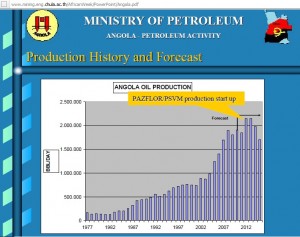 http://www.mining.eng.chula.ac.th/AfricanWeek/PowerPoint/Angola.pdf
http://www.mining.eng.chula.ac.th/AfricanWeek/PowerPoint/Angola.pdf
It is in stark contrast to what the notoriously optimistic IEA said in its Medium Term Oil Market Report about increasing oil production to 2.7 mb/d in 2016.
Libya:
24/6/2011 War overshadows peak oil in Libya
http://crudeoilpeak.info/war-overshadows-peak-oil-in-libya
Colombia:
The question is by how much will Colombia’s oil production increase and for how long?
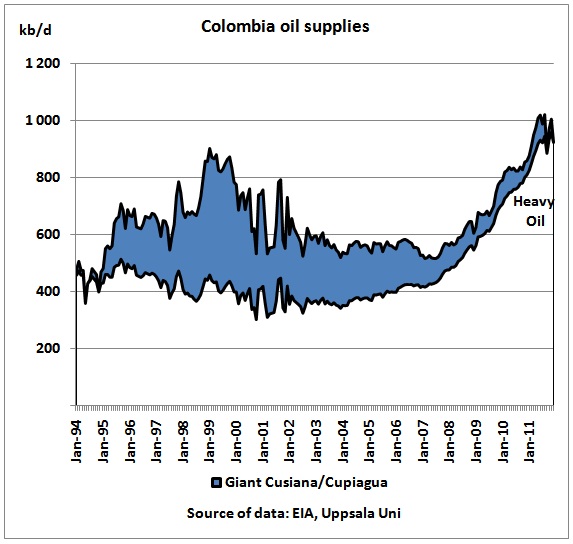 http://www.eia.gov/cfapps/ipdbproject/iedindex3.cfm?
http://www.eia.gov/cfapps/ipdbproject/iedindex3.cfm?
This graph shows that rapid increases in the last 3 years have stalled in 2011. The 1st peak was from the giant oil field Cusiana/Cupiagua which at its peak in 1999 produced 430 kb/d but in 2011 only 24 kb/d
This graph using data from Colombia’s Ministry of Mines and Energy shows that in December 2011 almost half of oil production was either stagnating or in a slight decline. Substantial growth in 2011 of 100 kb/d came from only 12 fields including Rubiales which produces heavy oil (12.5 API), similar to neighbouring Venezuela, and requires light oil or naphta for diluting the heavy crude.
So where is Keith’s number crunching on this in the next years?
(13) Citi Bank’s US energy independence myth
K. Orchison: Kohler doesn’t say so in his commentary but I wonder if he has been reading the new analysis from banking giant Citi.
Comment: Alan has not read this note: “the terms shale oil and oil shale are often confused…” However, the Citi report warrants its own analysis.
K. Orchison: Citi, in my interpretation, asserts that the IEA has committed the classic error of using yesterday’s information to forecast tomorrow’s outcomes and the bank predicts that a surge in discoveries and their conversion in to production should see a marked improvement in the oil supply outlook.
Comment: So if that is Keith’s “interpretation” where are the numbers on which type of discoveries (Conventional? Unconventional?). The Citi report warrants its own analysis.
K. Orchison: Australia comes in for a special mention: “Australia’s shale may also hold promise and drilling could be in for a breakout later this year and early next year, with oil field services companies positioning themselves for a ramp-up of activities.”
Comment: See under (5)
K. Orchison: Citi sums up the outlook like this: “The shale oil revolution is in full swing in North America. It is unlikely to stop there and eventually its impact will be felt globally. For now, the immediate, tangible market impact will be to drive down oil prices in the US versus the rest of the world. The US, after many weak starts, appears to be on course to achieve energy independence this decade.”
Comment: The energy independence myth has been thoroughly analysed in my first post on Alan Kohler’s article. Just look at the graph under (10)
(14) APPEA’s Adelaide conference and the Saudis
K. Orchison: All this, of course, is terrific grist to the mill of APPEA for its 52nd annual conference in Adelaide, because the association has lined up, in addition to de Margerie, the Saudi Arabian Minister of Petroleum and Mineral Resources, Ali bin Ibrahim al-Naim, the new executive director of the IEA, Maria van der Hoeven, and ExxonMobil’s Emma Cochrane, one of the executives of its Asia Pacific and Africa gas marketing activities, plus the chief executive of BHP Billiton Petroleum, Michael Yeager, and a bus load of local senior petroleum types led by its current chairman, David Knox of Santos, to talk to the theme of ‘The Energy Revolution’.
Comment: What will Naimi tell the conference: that high oil prices are unjustified?
 20/3/2012 Top oil exporter Saudi Arabia sought to soothe fears about high oil prices, saying world supplies were well in excess of demand and that $125-a-barrel crude prices were not justified given the anemic state of the world economy.
20/3/2012 Top oil exporter Saudi Arabia sought to soothe fears about high oil prices, saying world supplies were well in excess of demand and that $125-a-barrel crude prices were not justified given the anemic state of the world economy.
Saudi Oil Minister Ali Al-Naimi said the kingdom had satisfied all of its customers’ requests for oil and stood ready to raise output to full capacity of 12.5 million barrels per day (bpd), if needed.
Riyadh is now pumping 9.9 million bpd – the highest in decades – and is willing to produce at full capacity of 12.5 million bpd immediately, should demand warrant, Al-Naimi said. He said he expected output next month to stay at 9.9 million bpd.
http://www.tradearabia.com/news/ogn_214519.html
So what happened when Libyan oil went off the market?
According to the IEA, spare capacity must be delivered with in 30 days and held for 90 days
We see that Saudi oil came too late. And of course it was not of the same quality as the light Libyan oil.
Naimi should know better. His ex-Saudi Aramco chief Sadad-al-Husseini did some work a couple of years ago. They imply Saudi production could not go higher than 11 mb/d
2/3/2011
WikiLeaks cable from Riyadh implied Saudis could pump only 9.8 mb/d in 2011
http://crudeoilpeak.info/wikileaks-cable-from-riyadh-implied-saudis-could-pump-only-9-8-mbd-in-2011
And what will be reaction of the Saudis to the prospects of shale oil, as presented here:
2012 PETROLEUM OPPORTUNITIES IN SOUTH AUSTRALIA
e.g shale oil plays (Hess, Betaloo basin)
http://www.pir.sa.gov.au/__data/assets/pdf_file/0004/169222/Australia_House_Mar_2012_EMA.pdf
We have heard it already in late 2011
Resetting the energy conversation: the need for realism
Khalid A. Al-Falih, President and CEO, Saudi Aramco
21/11/2011
The emergence of abundant hydrocarbon resources including shale gas, the uncertainty in making renewables and other alternative forms of energy viable, the global economic maelstrom prompting a rethink in energy-related investments, and shifts in environmental policy require a more flexible approach able to deal with uncertainties and future challenges..
In plain English: Since you guys go for shale oil, we don’t have to pump more of our oil
In this way the Saudi’s will cover up their own oil peak.
K. Orchison: Meanwhile at CERAWeek in Houston – wonderfully described in The Wall Street Journal as the global energy elite’s own version of Davos, sans the skiing – top speakers have been arguing this past week that the shale revolution is “changing the political dialogue on energy.”
I think that’s pretty well the point that Kohler is making.
Comment: “political dialogue on energy”? That’s a good point. Here are the curves of political oil reserves and technical oil reserves from Jean Laherrere. They speak for themselves.
So instead of throwing in a French word to make some stylish reading, he should have visited the French website of ASPO to look for the above graph: http://aspofrance.viabloga.com/texts/documents
Conclusion:
Keith Orchison is member in the Energy White Paper Reference Group. The Australian Government and the EWP team do not like peak oil. So all sorts of verbal arguments are being used to try debunking it. As in Alan Kohler’s original piece, no number crunching was shown by Keith to prove it.
